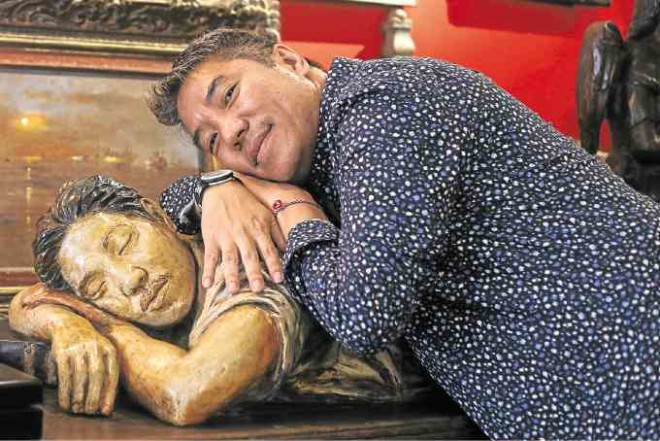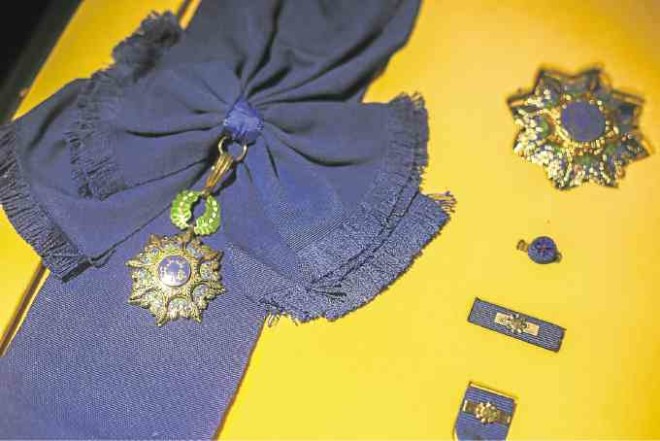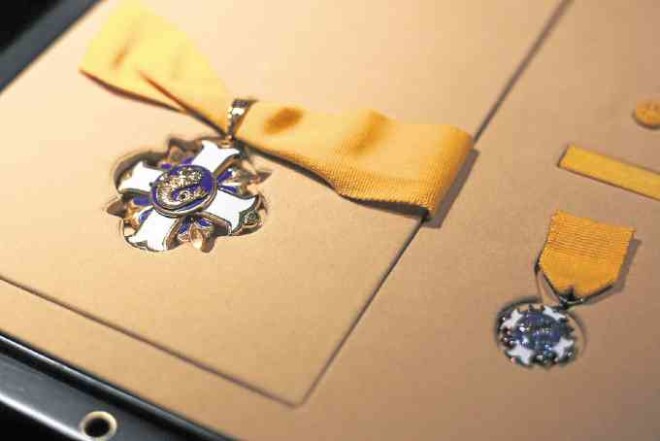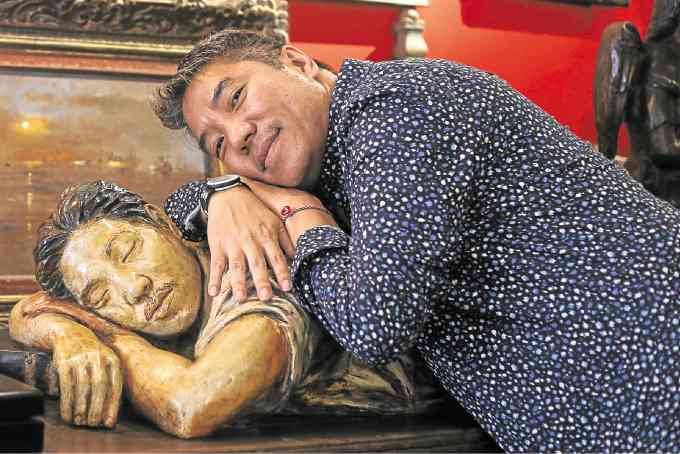
Entering Ambeth Ocampo’s apartment gives the visitor an idea of what it must be like inside the historian’s mind.
Imagine a slightly surreal sensorium where the recent and remote past coexist in a timeless now.
Pre-Hispanic bulol figurines jostle for space with antique santos and an impressive 18th-century carved altarpiece depicting Jesus and John the Baptist with Chinito features.
Felix Resurreccion Hidalgo argues aesthetics with Arturo Luz and BenCab while the ghosts of Antonio Luna and Apolinario Mabini hover.
Overseeing the proceedings is, of course, Rizal, wearing a curious and ever-so-slightly bemused expression, and as the host prefers, no overcoat.
“This is my refuge,” says Ocampo, who will be in Japan next week to receive the prestigious Fukuoka Prize, an award bestowed for “exceptional work in preserving or creating culture within the Asia-Pacific, and presenting it to the world.”
Scholar’s eye
It is a carefully curated environment, every painting, every artefact selected because it piqued his inexhaustible curiosity about our past. Ocampo started collecting art, books and historic papers as a
student at the Ateneo, paying on instalment out of his meager school allowance. The hoard, though fabulous by any standard, is idiosyncratic.
“It’s the scholar’s eye,” he says. “Many of the things I bought because they were interesting to me.”
The collection spills over from the sala into the adjoining study. The smell of books—thousands of them, neatly catalogued according to the Library of Congress system, all Filipiniana—is comforting.
“History is a solitary, almost monastic vocation,” says Ocampo, who once spent a seven-year stint at the Benedictine Abbey of Our Lady of Montserrat, as Dom Ignacio Maria, OSB, when he was in his 30s. He has kept a monk-like dedication to study even after he left the cloister.
“I write, I lecture, I Facebook,” he adds. “It gives you a public image which hides the fact that you spend hours in reading, study and reflection. The reason I can write a column in two hours is I have 30 years of reading behind it.”

Bare essentials
The library has actually been pared down to the bare essentials: Ocampo endowed the Holy Angel University in Angeles City with over 10,000 volumes, leaving only what he needed for his writing.
His art collection has been similarly culled. Every artefact tells a story: a terracotta bust of a strikingly attractive woman by sculptor Julie Lluch was modelled, he says, on the unfaithful wife of a fearsome warlord. She fell in love with her husband’s bodyguard, thus sealing their doom.
The bust itself would have met the same fate if Ocampo hadn’t snatched it up before the warlord could obliterate it.
The best story, by far, is told by another terracotta bust, also by Lluch: It depicts the 25-year-old Ocampo asleep at his desk, perhaps communing with Rizal, Aguinaldo and Juan Luna in his dreams.
Ocampo calls the slumbering figure his “twin.”
“People think it was all planned from the start,” he says.
21st-century ‘ilustrado’
But his current life as a gentleman-scholar, a 21st-century ilustrado in the age of social media, and a popular popularizer of Philippine history (to the chagrin of more hidebound academics) owes not a little to random fate.
“I wasn’t even good in school,” recalls Ocampo, who majored in Political Science before switching to Interdisciplinary Studies.
“I didn’t like the way history was taught. The textbooks were boring. Agoncillo. Zaide. It was all straight chronology. There was no human element.”
A term paper assignment drew Ocampo into the ambit of writer, artist and bon vivant Emilio Aguilar Cruz.
It was a life-changing experience.
“Abe,” in turn, introduced him to Carmen Guerrero-Nakpil, and his circle soon expanded to include the likes of Gilda Cordero Fernando, Nick Joaquin, Mario and Odette Alcantara.
Though several generations removed, these writers and intellectuals must have recognized an old soul in the young upstart, and a quick and inquiring mind—the ideal sponge to soak up their decades of accumulated knowledge and experience.

Demanding
They were incredibly generous with their time and advice, but also demanding. Cruz pressed him to re-read the “Noli” and “Fili” in the original Spanish, telling him that he would figure it out. He even gave him a copy of Umberto Eco’s “The Name of the Rose,” in the original Italian, and advised a regime of reading one book a day.
Around the same time, he met Teodoro Agoncillo by chance in a book launch. Though already frail and sickly, the eminent historian took a liking to the young man, and sort of took him under his wing.
“He asked me to visit him at his home,” he recalls. “When I got there he was wearing an oxygen mask. I would arrive at three in the afternoon and leave at 10 at night. Literally kwento na lang siya ng kwento. Had I known that he would die six months later, I would have visited more often.”
These weren’t just social visits, however. Agoncillo was schooling him. There were reading assignments when he left, and pop quizzes when he returned.
“Then I found out how interesting history could be,” recalls Ocampo. “Abe gave me the fun part [of history],
Agoncillo gave me the scholarly rigor. It was the best of both worlds.”
Logical step
Apart from his subjects at the Ateneo, he also sat in at the University of the Philippines when certain classes and teachers piqued his interest, such as Arsenio Manuel on Philippine anthropology or Pete Daroy on creative writing in Pilipino.
All of this newfound knowledge had to go somewhere, and writing was the logical next step. He already had a mentor in Doreen Fernandez, his English teacher at the Ateneo, and given that his role models were all extremely erudite and accomplished writers, Ocampo didn’t lack for encouragement.
“All it would have required was a dismissive tone,” he says. “Kung sinungitan lang ako nina Abe at Gilda, hindi na ako nagsulat. But because they were encouraging—and they were not encouraging to everyone—I was lucky.”
Ocampo wrote his first historical essay, on the fake Juan Luna drawings that were circulating at the time, for the Daily Express, one of the three broadsheets of the so-called “crony press.”
“It was still martial law, but history was considered a ‘safe’ subject,” he says.
To bolster the credibility of the then-unknown author, Abe wrote a letter to the editor in support of the essay.
The rest, pardon the pun, is history.
Iconoclastic
After the Edsa revolt of 1986, Ocampo started writing his column “Looking Back” for the Daily Globe.
“My first articles were iconoclastic,” he recalls. “I was looking for the personal side. Sabi ni Gilda [Cordero Fernando] kasi malikot ang isip ko—I’m always trying to look at things from a different angle.”
In 1990, he moved to Philippine Daily Inquirer, where he continues to enlighten and entertain readers.
Twenty five years and 30 books later, Ocampo is, hands down, the most popular writer of Philippine history. His quarterly lectures at Ayala Museum are invariably standing room only, his FB page has over 59,000 likes, and his books are perennial bestsellers—remarkable at a time when young people don’t seem to read anymore.
He also has the academic credentials to back up his writings: a masters degree in Philippine Studies from the De La Salle University and a doctorate from the University of London, not to mention a nine-year stint in government serving in the National Historical Commission, the National Commission for Culture and the Arts, and Malacañang.
He still teaches at the Ateneo de Manila University, whose history department he once headed. And he has been awarded the Presidential Medal of Merit and Order of Lakandula—the country’s second highest honor for a civilian.
Distrustful
Still, he gets no love from more traditional academics.
“Academia has always been distrustful of popularizers,” he says. “They think we dumb down [history]. The French term is ‘vulgarisateur.’ That’s what you do—you vulgarize. But history should be taken out of the ivory tower once in a while and returned to the people to whom it also belongs.”
The real role of the historian in the age of Duterte, Ocampo believes, is to engage the public.
“People forget that Agoncillo once wrote a column like mine in the 1950s,” he notes. “To this day the academics are not very happy. ‘Si Ambeth ma-chismis lang.’ But even if the form is playful, the material is not. We wish there were more public intellectuals, but there’s just Randy [David], Winnie [Monsod], me. How many history professors actually write? They don’t want to engage. They’re happy writing for academic journals, but how many people read journals? More academics should use the pulpit in order to educate. Unfortunately, there are very few of us who do that.”
At one point, he even wanted to write a history column in Pilipino for the tabloid “Abante.” It was to be called “Atras,” but negotiations broke down because he insisted on being next to sex columnist Xerex.
Two themes
Despite his continuing obsession with the past, Ocampo is fully at home in the modern world. Digital downloads and the Internet have given him access to more historical documents than ever before, and social media has grown his audience exponentially.
He has also expanded his range, from the colonial period to more recent history. He is working on an annotated edition of former president Fedinand Marcos’ diaries, written from 1969 to 1984. It is due next year, just in time for the late dictator’s 100th birth anniversary. A biography of former president Fidel V. Ramos is also in the works.
It’s a logical continuation of Ocampo’s great subject: the past and its continuing effect on the present.
“Two themes always come out when I write nowadays,” he says.
“One is, history doesn’t repeat itself, it’s people who repeat it. But we blame history because we don’t want to blame ourselves.”
“The second is, what should we do? Should we be imprisoned by the past? How do we liberate ourselves from it? Whenever people talk about history, they always misquote Rizal: ‘Ang hindi lumingon sa pinanggalingan…’ The real quote, which nobody knows, is much nicer. He says something like we should enter the future carrying a memory of the past. So you don’t forget, but you move forward.”
Once, in an uncharacteristic fit of Weltschmerz, Ocampo declared that he wanted to die at the age of 50 while he was still in full command of his faculties.
Now, at 55, he realizes that there’s too much work left to be done, faculties notwithstanding.
“I have many more years to go, and many more books to write,” he says.
He has been mulling over two projects for decades, a book on Antonio Luna and another on Apolinario Mabini, the two casualties of the first Philippine republic, one assassinated, the other hounded out of public life.
Negative view
The late Letty Jimenez Magsanoc, Ocampo’s editor in the Philippine Daily Inquirer, once asked him why he had such a negative view of Philippine history. He replied that that’s what the documents told him.
“One day I want to write a book called ‘Quezon’s Curse,’ because he wanted a government run like hell by Filipinos, and he got what he wanted,” he says. “We suffer that curse to this day. The Philippines is a nation of missed opportunities and broken promises.”
The depressing litany includes the betrayal of the Philippine revolution and the failure of the republic, the failure of martial law, the failure of Edsa I and II, the failure of “Daang Matuwid,” each succeeding president failing to live up to his early promise.
“Many times in our history, we had a chance to change the way we are, but we were too scared to follow through,” says Ocampo. “How do we turn it around? How can we make the past useful to the present so we can move forward? There must be a way to acknowledge the past and still move on. As Rizal says, we must enter the future carrying a memory of the past.”









































